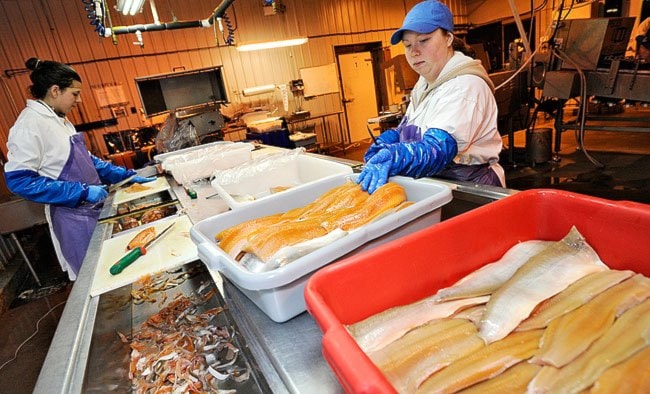Jonathan Lucas loves female Arctic char, the bigger the better, and he’s doing everything he can to breed them.
“Having all females has been a goal and a dream since before I got here, 12 years ago,” Lucas said.
“Here” is the Icy Waters fish farm that Lucas manages in Whitehorse. It’s now the first in Canada to experiment with a new selective breeding program that aims to produce only female fish.
It’s an idea he’s been chasing since he started at the farm over a decade ago. Having all females, or as close to that as possible, is important because they live longer, grow bigger, and fetch more money.
The problem is that males grow faster at first. That, combined with the wild swings of bitterly cold Yukon winters and relatively warm summers, makes things difficult.
When males get to their second summer, they are still below market weight of three pounds, but the warm water triggers them to start maturing. The males don’t get any bigger, but they develop testes, start behaving aggressively and harassing the female fish.
Once they mature, the males are focusing so much of their energy on breeding that their immune systems start to shut down, and they become much more susceptible to disease. They start dying off in droves, and all before they are big enough to sell.
“Last year, because of the summer we had, we actually lost about nine tonnes of fish. Fifteen to 20 per cent of some tanks just died in August and September last year ... that’s about $90,000 just wiped off the books,” Lucas said.
And that’s with a relatively cool summer last year. If it had been warmer, the losses would have been worse.
But now, partnered with a research team at Simon Fraser University, Lucas might just have found the perfect solution: zinc.
Sperm with male chromosomes has a higher zinc concentration, Lucas explained. By introducing a zinc-glutenate compound to fish sperm, breeders are able to separate sperm containing male genes from sperm with female genes, so only the female sperm get through to fertilize the fish eggs.
And the benefits aren’t just bigger fish.
“With farming, all things are connected. When I say we lose 15 to 20 per cent of a tank, that’s over a 10-week period. We try to get them taken out a couple times a day, but you miss some. If it’s warm water, the dead fish start to break down so it’s a loss for us financially, it’s a terrible loss for the fish, and we don’t want to be putting any more (contaminants) than we have to out into the environment. This is a way to help with that as well,” Lucas said.
It’s also safer, Lucas explained.
There is an older method for gender selection among fish. Farmers would subject fish fry to a testosterone bath. When fish are first hatched, they haven’t developed a specific gender yet. The testosterone forces female fish to develop testes, even though genetically they still have XX chromosomes. Cross that with female eggs, and you get more female fish.
The problem with that is twofold. First, fish treated with testosterone aren’t fit for human consumption, only their offspring are. Second, Arctic char have a redundant set of chromosomes that gets in the way.
But this new process doesn’t treat fish; it only treats fish sperm so there’s no risk of mutating or otherwise harming the females that are hatched.
Lucas said the program is still in its trial phase, with a test tank of around 2,000 fish, but he hopes to have it into full production by next spring.
All told, Icy Waters produces around 140 tonnes of fish every season, which works out to 80 tonnes of fillets being sold and shipped across the country.
Contact Jesse Winter at
jessew@yukon-news.com
